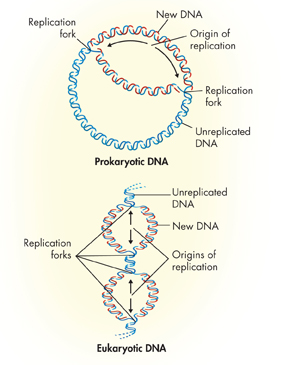Prokaryotic DNA Replication In most prokaryotes, DNA replication does not start until regulatory proteins bind to a single starting point on the chromosome. These proteins then trigger the beginning of the S phase, and DNA replication begins.  Replication in most prokaryotic cells starts from a single point and proceeds in two directions until the entire chromosome is copied. This process is shown in Figure 12–10. Often, the two chromosomes produced by replication are attached to different points inside the cell membrane and are separated when the cell splits to form two new cells.
Replication in most prokaryotic cells starts from a single point and proceeds in two directions until the entire chromosome is copied. This process is shown in Figure 12–10. Often, the two chromosomes produced by replication are attached to different points inside the cell membrane and are separated when the cell splits to form two new cells.
Eukaryotic DNA Replication Eukaryotic chromosomes are generally much bigger than those of prokaryotes.  In eukaryotic cells, replication may begin at dozens or even hundreds of places on the DNA molecule, proceeding in both directions until each chromosome is completely copied. Although a number of proteins check DNA for chemical damage or base pair mismatches prior to replication, the system is not foolproof. Damaged regions of DNA are sometimes replicated, resulting in changes to DNA base sequences that may alter certain genes and produce serious consequences.
In eukaryotic cells, replication may begin at dozens or even hundreds of places on the DNA molecule, proceeding in both directions until each chromosome is completely copied. Although a number of proteins check DNA for chemical damage or base pair mismatches prior to replication, the system is not foolproof. Damaged regions of DNA are sometimes replicated, resulting in changes to DNA base sequences that may alter certain genes and produce serious consequences.
The two copies of DNA produced by replication in each chromosome remain closely associated until the cell enters prophase of mitosis. At that point, the chromosomes condense, and the two chromatids in each chromosome become clearly visible. They separate from each other in anaphase of mitosis, as described in Chapter 10, producing two cells, each with a complete set of genes coded in DNA.

FIGURE 12–10 Differences in DNA Replication Replication in most prokaryotic cells (top) begins at a single starting point and proceeds in two directions until the entire chromosome is copied. In eukaryotic cells (bottom), replication proceeds from multiple starting points on individual chromosomes and ends when all the chromosomes are copied.
dd12.3 Assessment

-
Review How is DNA replicated?
Apply Concepts What is the role of DNA polymerase in DNA replication?
-
Review Where and in what form is prokaryotic DNA found? Where is eukaryotic DNA found?
Infer What could be the result of damaged DNA being replicated?
VISUAL THINKING
Make a Venn diagram that compares the process of DNA replication in prokaryotes and eukaryotes. Compare the location, steps, and end products of the process in each kind of cell.

Table of Contents
- Formulas and Equations
- Applying Formulas and Equations
- Mean, Median, and Mode
- Estimation
- Using Measurements in Calculations
- Effects of Measurement Errors
- Accuracy
- Precision
- Comparing Accuracy and Precision
- Significant Figures
- Calculating With Significant Figures
- Scientific Notation
- Calculating With Scientific Notation
- Dimensional Analysis
- Applying Dimensional Analysis




